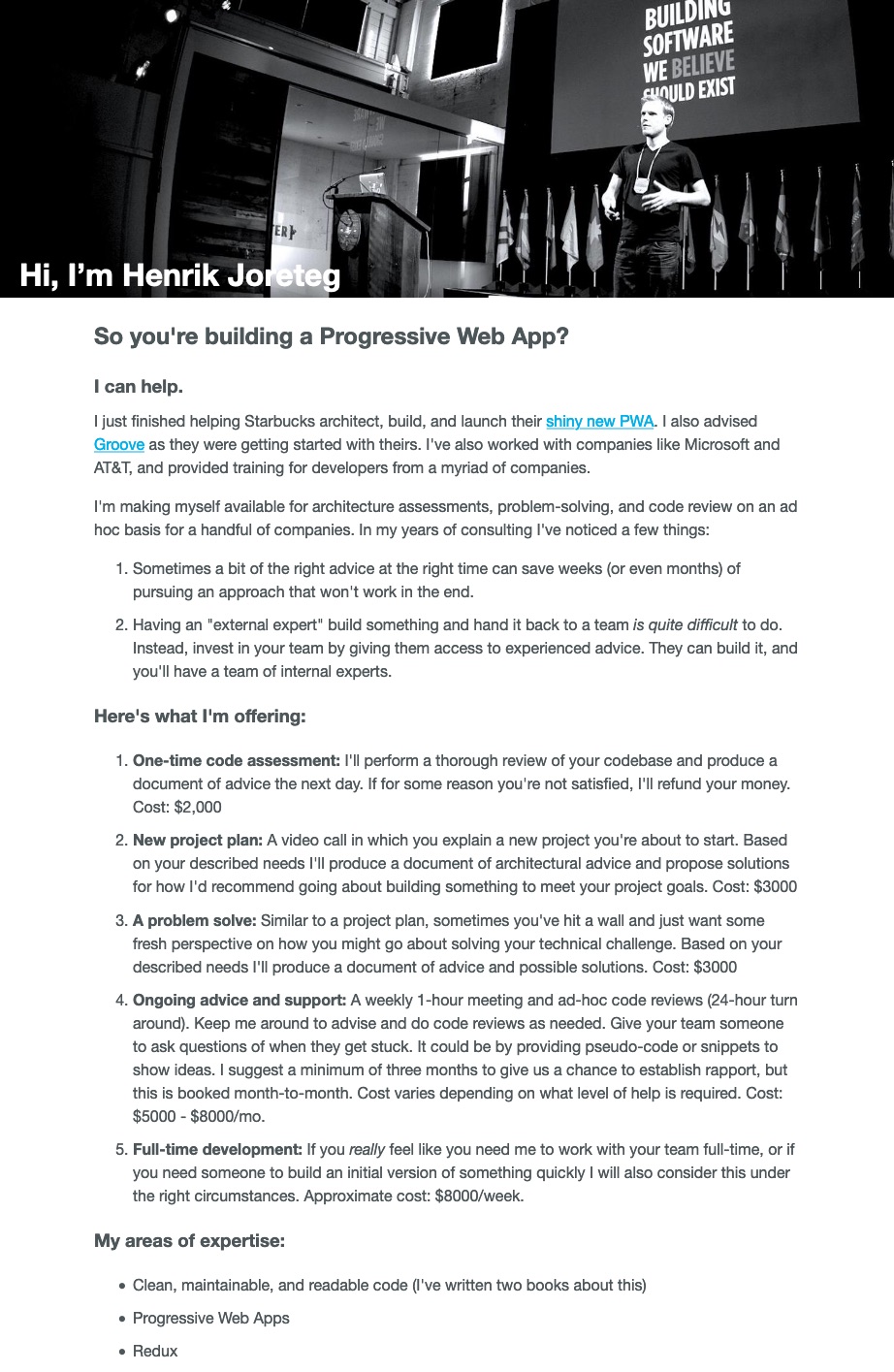Productized Services: From a Variety of Skills to a Value-Ladder
You’ve got a variety of skills you can sell as a freelancer, as a consultant. You’ve read into the benefits of packaging your skills as products:
- Your visitors have a good idea of what you can do for them;
- They get a sense of the costs of working with you (whether or not you advertise a public price), the next steps, and what they’ll get in the end;
- You get to create a story that your visitors can tell others about – a remarkable (remark-worthy) story.
You’ve started packaging your skills as services, but you’re asking yourself if you’re doing it right. You feel your services are a little scattershot.
Is there a way to make your service offerings more… sharp?
Let’s Say You’re a Developer
Maybe your situation is a little bit like this. You’re a developer, and…
- You can build whole applications;
- You can direct a team to build an application;
- You have a specialty in JavaScript, and you can do GraphQL, React, React Native, node.js;
- You can give strategic direction to your clients on technology choices.
And so you set out to productize your skills as services:
- Full-Time Developer: Get a complete application built…
XXXX per two-week period - Team Lead: I help you make sure your team is coordinated for a momentary development crunch…
XXXX per week - JavaScript Consultant: Get consulting on solving impasses with JavaScript. I specialize in GraphQL, React, React Native and node.js…
Approx. XXXX per month for a few calls per week - Tech Architect: Hone your tech strategy…
Approx. XXXX per half-day engagement
In this case, you’re offering multiple options, covering a variety of skills, for a variety of implicit situations your visitors might be finding themselves in.
But your services are still separately generic. If your visitor is looking for a team lead, you’re in competition with all the other team leads around. It’ll help your case to show your past experience as a team lead, show proof of your JavaScript chops, but your team lead offering is on its own. Same with each of your other offerings. But there’s a way through this problem.
Organizing Your Services Into a Value-Ladder
There’s another benefit of packaging your services:
- You can make each service offering compete against each other for a common “job-to-be-done”, for a common struggle.
Henrik Joreteg organized his packaged services in such a way that they compete against each other.
Henrik’s packaged services are all helping solve the same overall pain:
We’ve hit a snag building a Progressive Web App. We’re looking for help from an expert so we can get back on track and meet our goals.
In this case, Henrik’s services are competing against each other.
For our problem, should we get his one-time code assessment or just get him to take on a feature for us? Ouch, his full-time development price is steep. We’ll just go with the one-time code assessment.
Henrik’s services are organized in a value-ladder. Each option progressively adds more value than the previous option. All for helping for the same overall job (solving a problem building a Progressive Web App), but each solving a more specific struggle within that overall context.
Finding Your Own Overall Context
To go from having a variety of generic packaged services to a value-ladder, it helps to sharpen your understanding of your buyers.
In a recent article, I proposed these three levels of understanding your buyers.
- Not Sharp Enough: Understanding the Role, the Market and The Benefits.
In this case, you’re selling your services to team leads or CTOs in the market of web apps. With you, they’ll get better code, quicker projects, etc. - Sharp: Understanding the Problem and the Aspiration.
At Level 2, you’re finding a struggle you can help with (“we’ve hit a snag building a Progressive Web App”) and you’re finding an broader aspiration (“we want to get this out quicker so we can impress the investors”). - Sharpest: Understanding the Situations That Are Ripe for the “Switch”.
At Level 3, you’re digging further to find the real switching moments.
“After trying doing it internally three times, we said ‘enough is enough’, we need to find someone external so we can get moving.”
“After trying local external experts who ended up being just marginally good, we’re looking for the best in the industry so we can save face on our commitments”
Instead of sweating every new visitor for a sale, you can confidently know the situations when they’re ready for the “switch” away from the old, and toward you.
Maybe you’ll find multiple struggles you can help with. But maybe there’s a single thread weaving all of those together.
No matter how deep you dig, it pays to find your overall context. You’ll get a sharper story to tell, more confidence telling it (“I help people who are struggling to do X”), and a way to get your published service offerings doing all the selling for you.
Stay Sharp!
—
Pascal Laliberté
@pascallaliberte
